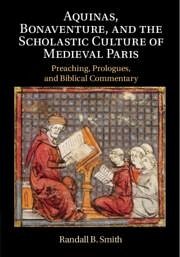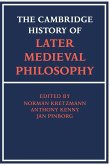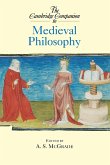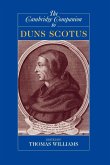Randall B. Smith (Houston University of St Thomas)
Aquinas, Bonaventure, and the Scholastic Culture of Medieval Paris
Randall B. Smith (Houston University of St Thomas)
Aquinas, Bonaventure, and the Scholastic Culture of Medieval Paris
- Broschiertes Buch
- Merkliste
- Auf die Merkliste
- Bewerten Bewerten
- Teilen
- Produkt teilen
- Produkterinnerung
- Produkterinnerung
Employing an in-depth study of the prologues and preaching skills of Thomas Aquinas and Bonaventure, this book will spur a fundamental reconsideration of the scholastic culture of the High Middle Ages and of the educational culture that informed their impressive body of work whose influence is still widespread today.
Andere Kunden interessierten sich auch für
![The Cambridge Companion to Medieval Logic The Cambridge Companion to Medieval Logic]() The Cambridge Companion to Medieval Logic114,99 €
The Cambridge Companion to Medieval Logic114,99 €![The Cambridge History of Later Medieval Philosophy The Cambridge History of Later Medieval Philosophy]() Norman KretzmanThe Cambridge History of Later Medieval Philosophy124,99 €
Norman KretzmanThe Cambridge History of Later Medieval Philosophy124,99 €![The Cambridge Companion to Medieval Philosophy The Cambridge Companion to Medieval Philosophy]() A. S. McGrade (ed.)The Cambridge Companion to Medieval Philosophy41,99 €
A. S. McGrade (ed.)The Cambridge Companion to Medieval Philosophy41,99 €![Bonaventure's 'Journey of the Soul into God' Bonaventure's 'Journey of the Soul into God']() Randall Smith (Houston University of St. Thomas)Bonaventure's 'Journey of the Soul into God'156,99 €
Randall Smith (Houston University of St. Thomas)Bonaventure's 'Journey of the Soul into God'156,99 €![The Cambridge Companion to Duns Scotus The Cambridge Companion to Duns Scotus]() Thomas Williams (ed.)The Cambridge Companion to Duns Scotus40,99 €
Thomas Williams (ed.)The Cambridge Companion to Duns Scotus40,99 €![Maimonides' Guide of the Perplexed Maimonides' Guide of the Perplexed]() Maimonides' Guide of the Perplexed33,99 €
Maimonides' Guide of the Perplexed33,99 €![Conscience in Medieval Philosophy Conscience in Medieval Philosophy]() Timothy C. PottsConscience in Medieval Philosophy50,99 €
Timothy C. PottsConscience in Medieval Philosophy50,99 €-
-
-
Employing an in-depth study of the prologues and preaching skills of Thomas Aquinas and Bonaventure, this book will spur a fundamental reconsideration of the scholastic culture of the High Middle Ages and of the educational culture that informed their impressive body of work whose influence is still widespread today.
Produktdetails
- Produktdetails
- Verlag: Cambridge University Press
- Seitenzahl: 464
- Erscheinungstermin: 5. September 2024
- Englisch
- Abmessung: 254mm x 178mm x 25mm
- Gewicht: 872g
- ISBN-13: 9781108789356
- ISBN-10: 1108789358
- Artikelnr.: 70726930
- Herstellerkennzeichnung
- Libri GmbH
- Europaallee 1
- 36244 Bad Hersfeld
- gpsr@libri.de
- Verlag: Cambridge University Press
- Seitenzahl: 464
- Erscheinungstermin: 5. September 2024
- Englisch
- Abmessung: 254mm x 178mm x 25mm
- Gewicht: 872g
- ISBN-13: 9781108789356
- ISBN-10: 1108789358
- Artikelnr.: 70726930
- Herstellerkennzeichnung
- Libri GmbH
- Europaallee 1
- 36244 Bad Hersfeld
- gpsr@libri.de
Randall B. Smith is the Scanlon Foundation Endowed Professor of Theology at the University of St. Thomas in Houston, Texas. He is the author of How to Read a Sermon by Thomas Aquinas.
I. Preliminaries: 1. Preaching and Principia at the University of Paris; 2.
The basic elements of the thirteenth century "modern sermon"; 3. Principia
and Sermo Modernus; II. Thomas Aquinas: The Logician Who Learned to Preach:
4. Rigans montes: Thomas's inception principium; 5. Hi est liber: Thomas's
Resumptio; 6. Thomas's student prologues; 7. After inception: early and
late prologues; 8. I have seen the Lord: Thomas's prototreptic prologue to
his commentary on the Gospel of John; 9. Aquinas, Sermo Modern-style
preaching, and biblical commentary; III. Bonaventure: The Scholastic with
the Soul of a Poet: 10. Bonaventure's inception Principium: Omnium artifex;
11. Bonaventure's Resumptio: an early attempt to think through the
hierarchy of the sciences; 12. Searching the depths of the Lombard: the
prologue to Bonaventure's Sentences commentary; 13. Exalting our
understanding: the prologue to Bonaventure's Commentary on the Gospel of
John; 14. The spirit of the Lord is upon me: the prologue to Bonaventure's
Commentary on the Gospel of Luke; 15. Bonaventure, Sermo Modernus-style
preaching, and biblical commentary; 16. A master's praise of scripture: the
prologue to Bonaventure's Breviloquium; 17. The union of Paris and Assisi:
the prologues to Bonaventure's later Collations; 18. The Reduction of the
Arts to Theology redux: the prologue to the Collations on the Six Days of
Creation; 19: Summary and concluding remarks.
The basic elements of the thirteenth century "modern sermon"; 3. Principia
and Sermo Modernus; II. Thomas Aquinas: The Logician Who Learned to Preach:
4. Rigans montes: Thomas's inception principium; 5. Hi est liber: Thomas's
Resumptio; 6. Thomas's student prologues; 7. After inception: early and
late prologues; 8. I have seen the Lord: Thomas's prototreptic prologue to
his commentary on the Gospel of John; 9. Aquinas, Sermo Modern-style
preaching, and biblical commentary; III. Bonaventure: The Scholastic with
the Soul of a Poet: 10. Bonaventure's inception Principium: Omnium artifex;
11. Bonaventure's Resumptio: an early attempt to think through the
hierarchy of the sciences; 12. Searching the depths of the Lombard: the
prologue to Bonaventure's Sentences commentary; 13. Exalting our
understanding: the prologue to Bonaventure's Commentary on the Gospel of
John; 14. The spirit of the Lord is upon me: the prologue to Bonaventure's
Commentary on the Gospel of Luke; 15. Bonaventure, Sermo Modernus-style
preaching, and biblical commentary; 16. A master's praise of scripture: the
prologue to Bonaventure's Breviloquium; 17. The union of Paris and Assisi:
the prologues to Bonaventure's later Collations; 18. The Reduction of the
Arts to Theology redux: the prologue to the Collations on the Six Days of
Creation; 19: Summary and concluding remarks.
I. Preliminaries: 1. Preaching and Principia at the University of Paris; 2.
The basic elements of the thirteenth century "modern sermon"; 3. Principia
and Sermo Modernus; II. Thomas Aquinas: The Logician Who Learned to Preach:
4. Rigans montes: Thomas's inception principium; 5. Hi est liber: Thomas's
Resumptio; 6. Thomas's student prologues; 7. After inception: early and
late prologues; 8. I have seen the Lord: Thomas's prototreptic prologue to
his commentary on the Gospel of John; 9. Aquinas, Sermo Modern-style
preaching, and biblical commentary; III. Bonaventure: The Scholastic with
the Soul of a Poet: 10. Bonaventure's inception Principium: Omnium artifex;
11. Bonaventure's Resumptio: an early attempt to think through the
hierarchy of the sciences; 12. Searching the depths of the Lombard: the
prologue to Bonaventure's Sentences commentary; 13. Exalting our
understanding: the prologue to Bonaventure's Commentary on the Gospel of
John; 14. The spirit of the Lord is upon me: the prologue to Bonaventure's
Commentary on the Gospel of Luke; 15. Bonaventure, Sermo Modernus-style
preaching, and biblical commentary; 16. A master's praise of scripture: the
prologue to Bonaventure's Breviloquium; 17. The union of Paris and Assisi:
the prologues to Bonaventure's later Collations; 18. The Reduction of the
Arts to Theology redux: the prologue to the Collations on the Six Days of
Creation; 19: Summary and concluding remarks.
The basic elements of the thirteenth century "modern sermon"; 3. Principia
and Sermo Modernus; II. Thomas Aquinas: The Logician Who Learned to Preach:
4. Rigans montes: Thomas's inception principium; 5. Hi est liber: Thomas's
Resumptio; 6. Thomas's student prologues; 7. After inception: early and
late prologues; 8. I have seen the Lord: Thomas's prototreptic prologue to
his commentary on the Gospel of John; 9. Aquinas, Sermo Modern-style
preaching, and biblical commentary; III. Bonaventure: The Scholastic with
the Soul of a Poet: 10. Bonaventure's inception Principium: Omnium artifex;
11. Bonaventure's Resumptio: an early attempt to think through the
hierarchy of the sciences; 12. Searching the depths of the Lombard: the
prologue to Bonaventure's Sentences commentary; 13. Exalting our
understanding: the prologue to Bonaventure's Commentary on the Gospel of
John; 14. The spirit of the Lord is upon me: the prologue to Bonaventure's
Commentary on the Gospel of Luke; 15. Bonaventure, Sermo Modernus-style
preaching, and biblical commentary; 16. A master's praise of scripture: the
prologue to Bonaventure's Breviloquium; 17. The union of Paris and Assisi:
the prologues to Bonaventure's later Collations; 18. The Reduction of the
Arts to Theology redux: the prologue to the Collations on the Six Days of
Creation; 19: Summary and concluding remarks.








